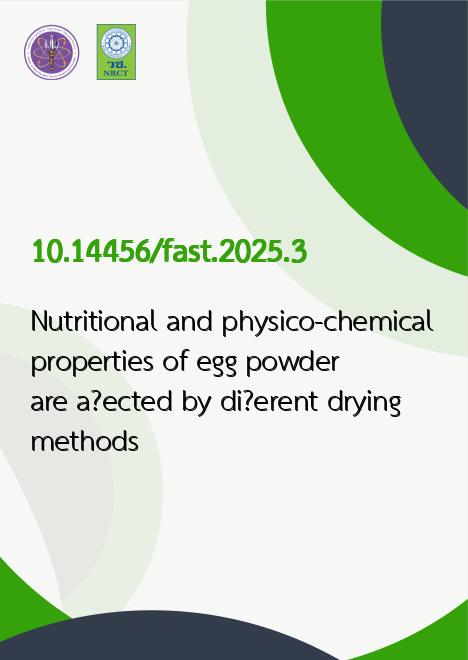
|
Nutritional and physico-chemical properties of egg powder are a?ected by di?erent drying methods |
|---|---|
| รหัสดีโอไอ | |
| Creator | Yaw Gyau Akyereko |
| Title | Nutritional and physico-chemical properties of egg powder are a?ected by di?erent drying methods |
| Contributor | Vida Opoku Edusei, Maxwell Adu, Solomon Odoi Anim, Georgina Benewaa Yeboah, Faustina Dufie Wireko-Manu |
| Publisher | Mahasarakham University |
| Publication Year | 2568 |
| Journal Title | Food Agricultural Sciences and Technology (FAST) |
| Journal Vol. | 11 |
| Journal No. | 1 |
| Page no. | 17-34 |
| Keyword | Egg powder, Freeze drying, Solar drying, Physico-chemical properties, Nutritional content |
| URL Website | https://ph02.tci-thaijo.org/index.php/stej/index |
| Website title | Food Agricultural Sciences and Technology (FAST) |
| ISSN | 2822-1001 (Print), 2822-101X (Online) |
| Abstract | This research aimed to determine the effect of solar and freeze-drying methods on the nutritional and physico-chemical properties of egg powder. Fresh egg samples were dried separately using solar and freeze-drying, and the physico-chemical properties, proximate, and mineral content were determined using standard methods. For the physico-chemical properties, solar drying caused a reduction in the TSS and pH from 0.83 °Brix and 7.95 for fresh egg to 0.55 °Brix and 6.89 (solar-dried egg powder) compared to that (0.95 °Brix and 7.73) of freeze-drying, though both methods had no effect on TTA. The drying methods reduced the color characteristics (L*-41.62, a*-2.68, and b*-15.88) of the fresh egg to (L*-34.27, a*-0.51, and b*-13.29) and (L*-28.08, a*-0.91, and b*-5.74) for freeze- and solar-dried egg powders, respectively. Except for moisture (75.98%), which decreased significantly to 2.32% (freeze-drying) and 6.70% (solar drying), protein (54.40-55.93%), fat (27.75-29.49%), ash (4.14-4.58%), carbohydrate (7.03-7.69%), and energy (485.41-519.83%) increased greatly for the egg powders compared to the fresh egg, which had 10.62%, 8.32%, 1.54%, 2.21%, and 130.56 kcal correspondingly. The two egg powders had comparable concentrations of K, Ca, Fe, Zn, and Mg, indicating equal effects of freeze- and solar-drying methods on mineral composition. The freeze-drying was more efficient in moisture removal and maintaining a high nutritional profile as well as color characteristics of the egg powder, and therefore presents a high potential for commercial production of egg powder to promote food and nutrition security. |